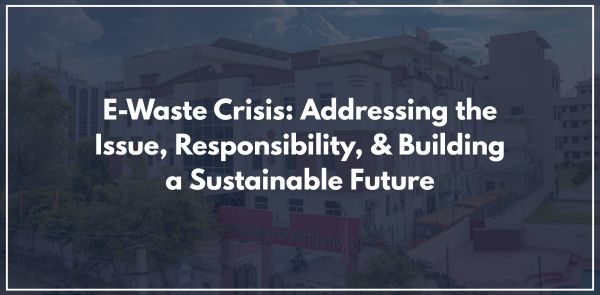
In a world driven by constant innovation and annual tech refresh cycles, we often celebrate the arrival of new devices—sleeker smartphones, smarter appliances, and faster laptops. However, behind every new gadget lies an uncomfortable truth: the growing crisis of electronic waste, also known as e-waste. As our dependence on electronics deepens, so too does the mountain of discarded devices piling up in landfills, often leaking hazardous materials into the environment. According to top BCA colleges in Jaipur and other educational institutions, a sustainable approach is required to address the problem. At Poddar International College, students actively engage in dialogue and discussions to find the necessary solutions.
But, a major change is required from within the industry itself. According to the Global E-Waste Monitor, the world generated over 59 million metric tons of e-waste in 2019, and this figure is expected to surpass 75 million metric tons by 2030. That’s the equivalent of throwing away over 1,000 laptops every second. The question is no longer whether e-waste is a problem—it is a problem. However, can tech companies lead the charge toward a sustainable solution?
E-waste encompasses all discarded electrical or electronic devices—from old TVs and broken phones to obsolete printers and tangled cables. Much of this waste contains toxic substances such as lead, mercury, cadmium, and flame retardants. If not properly processed, these chemicals can leach into soil and water, posing serious health and environmental risks.
Worse still, only 17.4% of global e-waste is formally collected and recycled, according to the UN. The rest is either incinerated, dumped illegally, or informally dismantled in unsafe conditions—often in developing countries with minimal regulations.
Several factors are fueling the e-waste explosion:
While consumers play a role, the most significant burden—and opportunity—lies with tech companies. As producers and innovators, they have the power to rethink how electronics are designed, manufactured, and disposed of. Fortunately, the tide is beginning to turn.
One key to reducing e-waste is designing products that last longer and are easier to repair. This includes:
Building products that are durable, upgradeable, and serviceable could dramatically extend product lifespans—and reduce the need for frequent replacements.
Several tech giants have launched programs aimed at encouraging device returns and proper recycling:
However, critics argue that these programs often lack accessibility and awareness. At times, they don’t guarantee that collected devices are recycled responsibly.
Another essential area of innovation is sustainable materials. E-waste isn’t just a problem—it’s also a resource. Electronics are rich in valuable materials like gold, silver, copper, and lithium. Mining e-waste for these elements (a process called urban mining) can be more efficient and environmentally friendly than extracting raw materials from the Earth.
Some companies are already taking action:
These innovations signal a broader shift toward a circular economy, where materials are reused continuously to minimize waste. A BCA course in Jaipur at Poddar International College can help you understand these latest technologies more comprehensively.
Government regulations are also forcing tech companies to take sustainability seriously. The European Union leads the charge with policies like:
Other countries are following suit, implementing extended producer responsibility (EPR) laws that hold manufacturers accountable for the entire lifecycle of their products.
Consumers are growing more conscious of the environmental footprint of their devices. Increasingly, buyers are factoring sustainability into their tech purchases—asking questions like:
This shift in consumer behavior is pushing companies to compete on sustainability as much as on specs and design.
The answer is--yes, but it won’t be easy. Tech companies must move beyond symbolic gestures and take real, measurable steps to reduce e-waste. This means:
Equally, governments must enforce regulations, invest in recycling infrastructure, and educate citizens. Moreover, consumers must be empowered to make better choices—demanding products that last longer and do not cost the planet.
The e-waste crisis is a technological paradox: the same innovation that propels our world forward is leaving behind a trail of ecological damage. But it also presents an opportunity—a chance to rethink how we design, use, and dispose of technology.
At Poddar College, the best MCA college in Jaipur, we believe that education plays a crucial role in addressing the e-waste crisis. By fostering awareness and encouraging sustainable practices among our students, we can contribute to a future where technology respects the planet we share. If tech companies rise to the occasion, the future can be both digital and sustainable. The gadgets we love don’t have to come at the Earth’s expense. With the right mix of innovation, regulation, and responsibility, we can build a world where electronics connect us while preserving our environment.
FAQs
1. What is the e-waste crisis in India?
India produces approximately 3.2 million metric tons of e-waste annually. There is a growing e-waste crisis in the country due to the increasing consumption of electronic devices. However, the issues are being addressed, with new ways devised for standard disposal methods and sustainable infrastructure.
2. How harmful is e-waste?
Students of IT colleges in Jaipur and other cities learn about the concern of increasing e-waste in the country. E-waste is considered hazardous because it produces toxic materials that are harmful to health and the environment.
3. What are 5 examples of e-waste?
Five examples of e-waste include mobile phones, computers, microwave ovens, televisions, and printers. E-waste generally encompasses electronic devices that are no longer functional or in use and hence discarded.